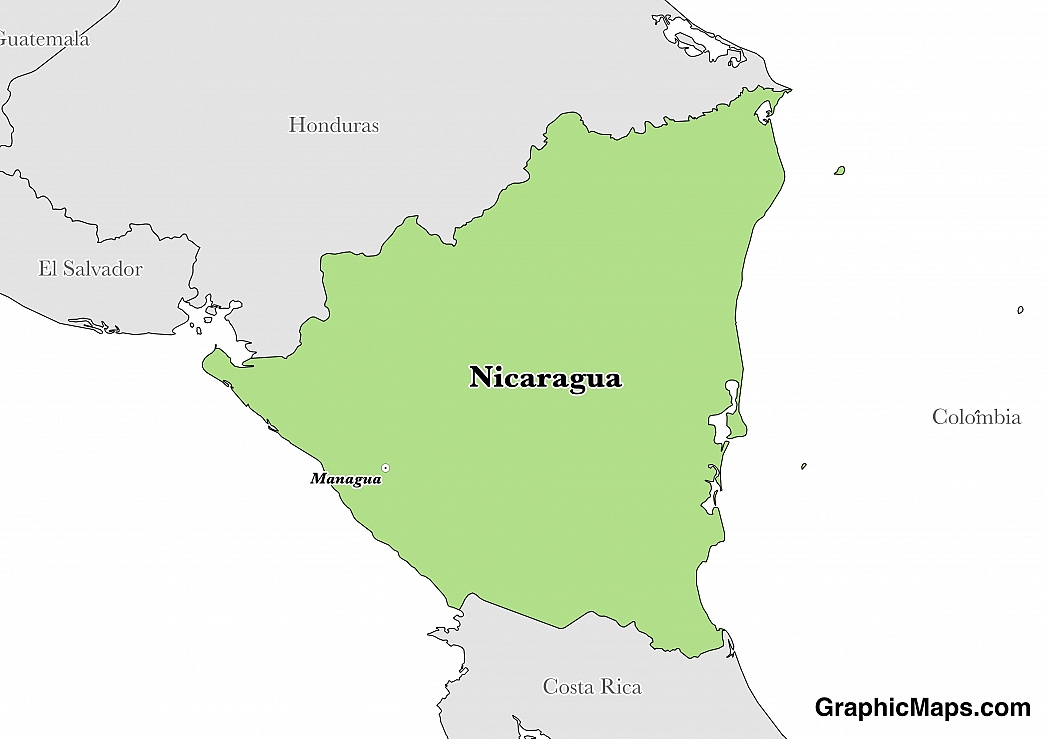Where is Nicaragua?
Located in Central America, Nicaragua has a 1,253.00 km border with Costa Rica (313 km) and Honduras (940 km). It has a 910.00 km coastline. Nicaragua and Costa Rica regualarly dispute the border area around the San Juan River.
Managua is the capital City of Nicaragua. It was founded in 1819 but officially got the title of capital city in 1852. It is the biggest city in size and also leads the country in population. As of the 2015 census, Managua had a population of 2,205,676 inhabitants in the city with the metropolitan areas boasting more residents. Managua has a range of tourist sites from casinos, museums, lakes, lagoons in the city center, festivals and much more.
Read more on Nicaragua's CapitalNicaragua is a North American country covering 130,370.00 km2 of which 7.96% is water and 119,990.00 km2 is land. This makes it the 96th largest country in the world and slightly larger than Pennsylvania; slightly smaller than New York state. Its geographic coordinates are 13 00 N, 85 00 W and Managua is the capital city.
The name Nicaragua comes from the nameof the largest indigenous settlement that was found at the time of the Spanish arrival.
Its ISO code is NI.
Geography
Nicaragua has a mean elevation of 298 m above sea level.
It has a climate that is tropical in the lowlands, and cooler in the highlands. Its terrain is mostly made up of coastal plains, interior mountains, and volcanoes.
Population
Nicaragua has a population of 5,966,798 making it the 110th largest in the world. The majority of the population lives in the western half of the country.
Spanish is the official language. The major ethnic group reported is mestizo. The majority of the country is Roman Catholic or Evangelical Christian.
The official language of Nicaragua is Spanish. It is a romance language in the Indo-European language group. Spanish is used in the media, schools, by the government, and by Nicaraguans in their daily lives. The dialect used in the country is Central American Spanish. 95.3% of the country’s population speaks the language. There are 27 letters of the Spanish alphabet. Despite similarities between Nicaraguan Spanish and the Spanish spoken in other countries, there are distinguishing characteristics in the pronunciation of some words. Minority languages in the country include Rama, which is close to extinction, Sumo, Garifuna, and Miskito, which is spoken by 2.2% of the population. Other languages existing in Nicaragua include Chinese, German, Arabic, and Italian.
Read more on Nicaragua's LanguagesThe dialing code for the country is 505.
Government
Nicaragua is an independent country. It gained independence from Spain in 1821. Its constitution was last ratified in 1987.
The Republic of Nicaragua is a constitutional democracy with proportional representation. The president is the head of state as well as the head of government. The government, made up of the president, vice president, and the cabinet, exercises executive powers while the legislative powers rest on the National Assembly. The President and the Vice-President are placed on one ballot and get elected through simple majority for five-year terms. All but two of the 92 deputies of the National Assembly are elected through proportional representation for five-year terms. The immediate former president and the presidential candidate who came in second in the last election get the remaining two seats. The president appoints the members of the cabinet, and the National Assembly confirms them.
Read more on Nicaragua's GovernmentEconomy
Factoring in Purchasing Power Parity, Nicaragua's GDP is $33,550,000,000.00 (USD) with $5,300.00 (USD) per capita. This makes it the 126th largest economy and its citizens the 162nd richest in the world. The currency of Nicaragua is the Cordoba (NIO).
Its major export partners are the United States, Mexico, and Venezuela. Its main exports are coffee, beef, gold, sugar, and peanuts. Its major import partners are the United States, China, and Mexico. Its major imports include consumer goods, machinery and equipment, raw materials, and petroleum products.
Flag
The Republic of Nicaragua’s flag has undergone several changes. The first few flags comprised of blue and white to a tricolored flag of yellow, white, and scarlet. Finally, after years of civil war, Nicaragua reintroduced the flag of the Former United States of South America as their flag. The flag is comprised of two rectangular stripes of white and blue with a triangular coat of arms in the middle of the white panel. Inside the coat of arms, there are five volcanoes, a red cap, a rainbow and white sun rays. The blue color stands for the Caribbean Sea and the Pacific Ocean while the white symbolizes peace. The triangular coat of arms stands for equality. The red cap stands for freedom, and the five volcanoes represent the five former states of the United States of South America. The remaining elements stand for the bright future of Nicaragua. The five states of the dissolved union all have similar colors for their flags. It is only Nicaragua’s flag which has a rainbow with a violet color on their flag. The others have similar colors with differences only on their coat of arms designer.
Read more on Nicaragua's FlagThis page was last modified on January 17th, 2018
More on Graphicmaps

Published on 2019-11-06
What is a Trade Embargo?

Published on 2019-11-04
Which Two Countries Used to Have the Same Flag?

Published on 2019-09-16
What Is the Only Two-Sided State Flag?

Published on 2019-09-16
Which Country Flag Looks Like the Texas Flag?

Published on 2019-08-29
Flags That Resemble the US Flag

Published on 2019-08-20
